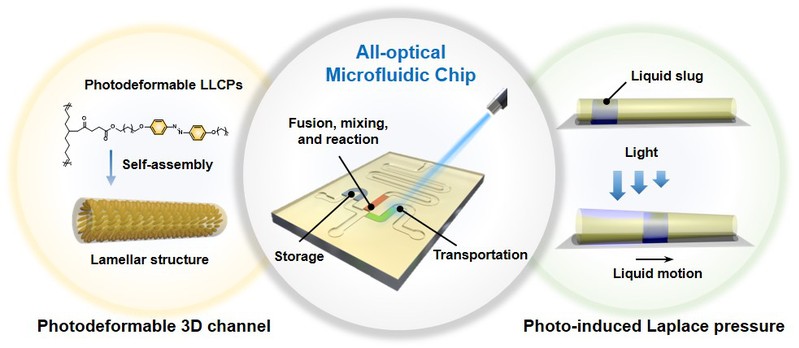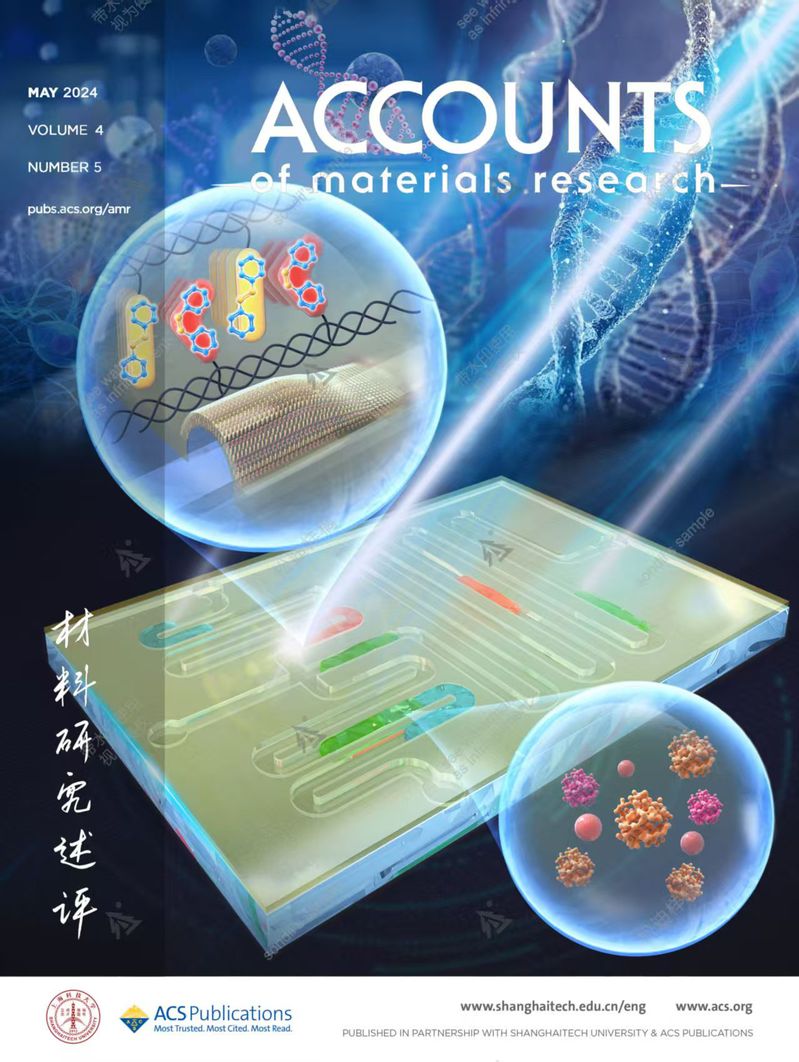搜索
Title: All-Optical Microfluidic Technology Enabled by Photodeformable Linear Liquid Crystal Polymers
Author: Lixin Jiang, Lang Qin, Feng Pan, Yanlei Yu*
Journal: Acc. Mater. Res., 2025, 6, 274-284
Abstract:
The microfluidic biochemical/immunoassay systems typically consist of microfluidic chips, fluid driving devices, and detection components. The core of the system is the microfluidic chips based on microfluidic technology, which are typically constructed with nonresponsive materials such as silicon, glass, and rigid plastics, thus requiring complex external air/liquid pumps to manipulate the samples. The external equipment renders the microfluidic systems cumbersome and increases the risk of biosample contamination. The all-optical microfluidic chip (AOMC) integrates all necessary microfluidic units and uses light to manipulate microfluids, which has the potential to completely solve the major problems of miniaturization and integration in microfluidic systems. The photocontrolled manipulation in AOMCs facilitates contactless interaction with liquids, eliminating the need for physical interconnects such as complex external electric, hydraulic, or pneumatic devices and replacing the traditional microfluidic components such as pumps, mixers, and separators, which offers AOMCs improved flexibility, robustness, and portability. However, impeded by photocontrolled principles and appropriate materials, AOMCs and photocontrolled biochemical/ immunoassay analyzers have never been created.
This Account highlights our efforts toward the new conception of all-optical microfluidic technology enabled by photodeformable linear liquid crystal polymers (LLCPs). We propose a novel mechanism to drive microfluids by the photoinduced Laplace pressure (asymmetric capillary force) and construct the first photodeformable 3D channel with newly designed photodeformable LLCPs possessing superior processability and photodeformability. The attenuated light is utilized to precisely control the axial asymmetric deformation of the 3D channels, which generates Laplace pressure, driving the fluids spontaneously toward the narrow end of the microtubes. Consequently, the photodeformable 3D channel integrates dual functions of the fluid channel and the pump, which is suitable for the construction of AOMCs, the core components of all-optical microfluidic technology, and lays the foundation for the miniaturization of microfluidic systems. By replacing the conventional chip materials with the photodeformable LLCPs, we construct the AOMC for the first time and achieve noncontact, accurate, and efficient manipulation of microfluids using a single light source, which plays an important role in solving the core conundrum of the cumbersome external equipment in the microfluidic chip systems. The AOMCs provide a robust platform for biochemical analysis such as protein detection and the catalytic oxidation reaction with minimal sample consumption, reduced reaction times, and enhanced portability, thus demonstrating the potential in in vitro detection with the ultratrace sample. Finally, we discuss the future challenges and opportunities inherent to all-optical microfluidic technology.

论文链接:https://pubs.acs.org/doi/10.1021/accountsmr.4c00318
PDF下载:![]() All-Optical Microfluidic Technology Enabled by Photodeformable Linear Liquid Crystal Polymers.pdf
All-Optical Microfluidic Technology Enabled by Photodeformable Linear Liquid Crystal Polymers.pdf
文章概述:
微流控技术是一种精确操纵微纳米流体的技术,可以将传统实验室的生化分析单元集中在几平方厘米的芯片上,在临床诊断、药物筛选等生命科学领域具有不可替代的作用。近年来,微流控芯片自身的尺寸不断缩小,然而其外置机械驱动设备复杂而庞大,制约了其进一步发展。我们致力于开发全光控微流体技术并构筑全光控微流体芯片,以非接触式的光场驱动替代外置机械驱动,创新微流体操控机制,实现微流控系统的集成与简化。为此,创制可用于微流体操控的光控致动材料至关重要。光致形变液晶高分子材料能够在光刺激下发生光敏基元团的异构化与液晶基元的排列变化,通过协同作用引发从分子到介观、再到宏观的多级结构变化,最终实现大幅度、可逆的形变和机械运动。因此,光致形变液晶高分子是构筑全光控微流体芯片的理想材料,可以解决现有微流控系统“外置设备累赘”的瓶颈问题。









